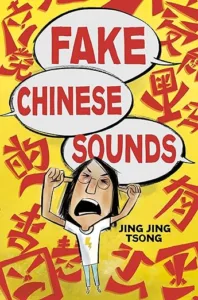Fake Chinese Sounds
Jing Jing Tsong
Kokila
Published April 30, 2024
Amazon | Bookshop | Goodreads
About Fake Chinese Sounds
A middle-grade graphic novel about a Taiwanese American girl navigating identity, bullying, and the messy process of learning to be comfortable in her skin.
Between homework, studying, and Chinese school, Měi Yīng’s summer is shaping up to be a boring one. Her only bright spots are practice with her soccer team, the Divas, and the time spent with her năi nai, who is visiting from Taiwan. Although Měi Yīng’s Mandarin isn’t the best and Năi Nai doesn’t speak English, they find other ways to connect, like cooking guōtiē together and doing tai chi in the mornings.
By the end of the summer, Měi Yīng is sad to see Năi Nai go—she’s the complete opposite of Měi Yīng’s serious professor mother—but excited to start fifth grade. Until new kid Sid starts making her the butt of racist jokes. Her best friend, Kirra, says to ignore him, but does everyone else’s silence about the harassment mean they’re also ignoring Sid . . . or her? As Sid’s bullying fuels Měi Yīng’s feelings of invisibility, she must learn to reclaim her identity and her voice.
My Review
One of the many reasons I wanted to read this book is that my older daughter is studying Chinese in school. I thought this book would be something we would enjoy talking about—and we did!
Since Měi Yīng attends Chinese classes on Sundays, some of the panels show her working on what appear to be homework assignments or journal entries. They contain Chinese characters positioned with context clues so that even readers unfamiliar with the language will be able to piece together what’s being said. The panels also show conversations between Měi Yīng’s mom and grandmother. Standard speech bubbles show when characters speak English to one another. When characters speak Chinese, the speech bubbles have a different background color, and the text appears in all uppercase letters. I love that this simply and visually cues readers that the characters are not speaking those lines in English.
The pages in which Năi Nai teaches Měi Yīng Chinese words are also cleverly done. The panels set up the idea that Měi Yīng’s grandmother is teaching her the Chinese words for things. Then, a page shows Měi Yīng in its center, with the things around her labeled with Chinese characters and pinyin (phonetic spelling of the characters) for the objects around her.
I loved that. It’s so immersive, and it perfectly captures that experience. Měi Yīng’s relationship with Năi Nai is also super cool. They practice tai chi and cook together and develop a connection wholly different than Měi Yīng’s relationship with her mother, who is more buttoned up and stoic.
The other theme the story focuses on is bullying. Měi Yīng overhears people making fun of the way her mom and grandmother speak. Then, a classmate begins regularly harassing her. People tell Měi Yīng to ignore the cruel comments, which leaves her feeling as though her friends are ignoring how those statements affect her.
The author presented this aspect of the story really well, too. It was easy to see how deeply the racist comments affected Měi Yīng, and how betrayed she felt when her friends didn’t speak up. Eventually, Měi Yīng does find a way to resolve the conflict, but it doesn’t happen easily.
Měi Yīng also plays soccer. While the story isn’t about her prowess on the field, her role on the team and performance in the games does impact the story. I liked that the author included sports as a part of Měi Yīng’s interests.
All in all, this is such a smart book! I love how accessible it makes speaking Chinese, and the character relationships and conflicts play out in believable and engaging ways. I highly recommend this for readers who enjoy graphic novels about fitting in, playing sports, learning another language, or family relationships.
Content Notes
Recommended for Ages 8 to 12.
Representation
Měi Yīng is Taiwanese American.
Profanity/Crude Language Content
None.
Romance/Sexual Content
None.
Spiritual Content
None.
Violent Content
Some racist comments directed at or about Měi Yīng and her family.
Drug Content
None.
Note: This post contains affiliate links, which do not cost you anything to use but help support this blog. I received a free copy of this book in exchange for my honest review. All opinions are my own.
Marvelous Middle-Grade Mondays
I’m sharing this post as a part of a weekly round-up of middle-grade posts called Marvelous Middle-Grade Mondays. Check out other blogs posting about middle-grade books today on Marvelous Middle-Grade Mondays at Always in the Middle with Greg Pattridge.



















I do love stories with grandparents playing an important role. This sounds like it has all the elements for a great MG book. Thanks for telling me about it.
Me too! Sure thing, Rosi. Happy MMGM!
I would not have chosen this one but after reading your review it is on top of my future read list. The character and story line sound perfect for discussion. Happy MMGM!
I think this would have gone under my radar if it weren’t for the author reaching out to me directly, which I am so grateful for. My daughter is in her second year of learning Chinese in school, and although she doesn’t read middle grade fiction anymore, I thought this book might end up being something cool for us to talk about and a way to learn a bit more together. I’m really glad I read it– and I hope you enjoy it when you get a chance to read, too! Happy MMGM to you!
This sounds like such a cool graphic novel, Kasey! I really appreciate you bringing it to my attention, since I hadn’t seen it before. I’m intrigued by the bilingual structure that emphasizes Měi Yīng’s experience learning Chinese, and her relationship with her Năi Nai sounds so compelling as well. Thanks so much for the thoughtful review, as always, and have a great week!
I’m glad you’re intrigued. I loved the bilingual structure, too– I don’t know if I’ve ever seen anything quite like it before, but I read such a small sliver of the graphic novels that are available. It might be more common than I realize. If you get a chance to check this book out, I hope you enjoy it! Hope you have a great week as well. 🙂
The premise reminds me of The Not-So-Simple Question by Christina Matula, which explores similar topics, minus the bullying. Happy MMGM
This sounds like a book that my daughter and I would have enjoyed reading when she was younger. She’s adopted from China and took Chinese lessons. Sadly, she’s still having to deal with racism at work. Thanks for featuring this book this week.
Yeah! It sounds like something that would have been a really good fit. Ugh for her having to deal with racism at work. That’s horrible. I hope that kids reading more books like this one helps the next generation be more empathetic. <3
Oooh! I’ll have to check that out! Thanks, Brenda. 🙂